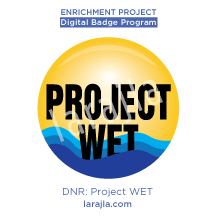 Project WET deals with water issues from healthy drinking water to conservation. It is designed for kids aged 5-18.
Project WET deals with water issues from healthy drinking water to conservation. It is designed for kids aged 5-18.
Steps
1. DNR in your state.
Find the Web site of the Department of Natural Resources in your state. Explore the educational offerings specific to your state. Locate your state’s Project WET materials.
2. Project WET online.
www.projectwet.org
Review the Project WET site. Learn about its history, goals and how it works.
3. Project WET materials.
Some materials come free with training. Some you can purchase. Review the materials available on the Web site and store.
NOTE: Some materials in the store are free.
4. Participate in a Project WET workshop.
Project WET is a free workshop that gives educators tools to teach water resources. Upon completion of the workshop, participants receive the activity guide at no charge. Though the workshops are designed for teachers to incorporate environmental science into their curriculum, many adults find these materials are also beneficial for working with youth groups. Review the materials you receive after the workshop and find some you would like to do.
5. Incorporating science into other subjects.
Materials in Project WET reach beyond environmental science. The concepts are designed to be used with health, language arts, history, math and more. Find ways of incorporating Project WET materials into other areas.
6. Beyond Project WET.
Explore other water science programming / educator guides also offered by the Department of National Resources (DNR). If you find any that interest you, explore those as well. Remember to look beyond “teacher” offerings. See what Project WET has to offer parents, corporations, aquariums, etc.
- WOW! Wonders of Wetlands
- Healthy Water, Healthy People
- Conserve Water
- Discover Floods
7. Check out Project WET in other states.
Examine offerings from other states. Compare to find out what materials are also used by other states and those specifically made for them. Are there materials you can use as well?
8. Incorporating Project WET with Girl Scouts.
Project WET has activities that work with Girl Scout badges and patches. Look through the Project WET book to see what activities you can incorporate into your Girl Scout meetings / events.
9. Incorporating Project WET with Boy Scouts.
Compare the offerings of Project WET with individual merit badge books to find activities to incorporate Project WET with Boy Scout awards.
10. Share with youth.
Share some of the information you received in training or from your materials with youth. This can be a troop, group or even individuals. Use your materials to create a summer camp day or week to encourage kids to become more aware of environmental science.
11. Create an activity box.
Create an activity box based on the program / youth you work with to introduce adults to Project WET. Include instructions on how the activity works and where adults can get their own materials if they are interested in learning more.
12. Service.
Design a service project with Project WET in mind. Run it yourself or ask others to help. Ask participants to evaluate the program after it has completed and offer creative criticism to improve your service project.
13. Become a trainer / coordinator.
Find out what you need to do to become a trainer / coordinator for Project WET.
14. Explore ways to share Project WET.
Find ways to share Project WET with others beyond the steps above.
Sites to Explore
- www.butlerwebs.com/hunting/statelist.htm
- www.projectwet.org
- www.nationalwatercenter.org
- www.pbs.org/wgbh/pages/frontline/poisonedwaters
Leave a Reply